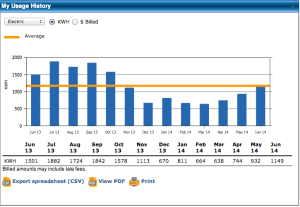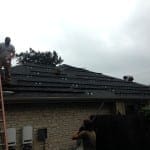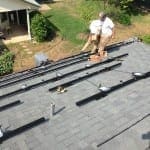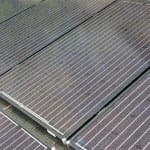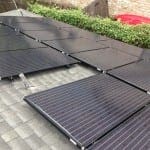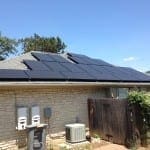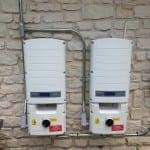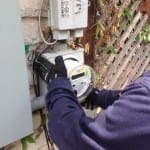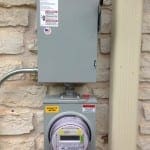The writing is on the wall. The future is here and it’s time to embrace the technologies that will carry us as a country and planet to a sustainable world.
Lion’s Share’s office is currently based out of my home and one day in February while we were working hard a gentlemen rang my doorbell. I was about to launch into my “No solicitations” routine when I noticed he worked for “Revolve Solar” (Sadly, they went out of business). Intrigued, I listened to what he had to say and apparently, my home was a good candidate for solar panels and that the 30% government tax credits would be expiring in 2016. Not only that, but the city of Austin also has a tax incentive program as well (~$1,100 per kW) and that with the combined credits I could potentially take my home and office almost completely off the grid while adding significant equity and doing something smart for the city and planet. Sounded like a Win-Win-Win to me.
Research Phase
I decided to post to my social networks and ask people what they knew about solar. The response was unreal. Apparently, in my group of friends and Austin, there is an exploding industry of solar companies and workers. I was flooded with messages from people offering to come by my house and give estimates. I took a few appointments and got a pretty wide variety of companies and people. It seems that the government tax credits has led to a bit of a gold rush and there appears to be a lot of fly by night solar companies trying to cash in. I took the hard nose approach of asking for references, reviewing people’s websites for professionalism, reading online reviews and asking for bids. This immediately stopped about half the guys in their tracks. I recommend this approach any time you hire a contractor to work on your home. Nothing wrong with not being totally pro but I wasn’t about to let just anyone drill holes in my roof and try to sell me $22k in solar panels. Re:volve Solar was by far the most professional and mature company of the bunch. They had a sales manager, account manager, fully insured and bonded and tons of glowing reviews online. I talked things over with my wife, we made the decision to work with them and pulled the trigger on March 27th. We decided to go with 30 275 watt panels that would generate around 8kw. Our energy usage per month is around 500 to 1800kw and system should be able to more than cover us in the winter. In fact, we’ll be pushing energy back into the grid and earning energy credits. During the summer months, we’ll likely pull from the grid for around 20-30% of our energy.
Benefits of Going Solar
- PV prices are at historic lows thanks to reduced equipment pricing, rebates and tax credits.
- Solar boasts a strong return on investment of approximately 25% with an average payback period ranging from three to nine years.
- Solar systems provide reliable energy that is virtually maintenance-free for more than 20 years.
- Solar puts energy management decisions in the hands of home and business owners as they produce their own clean electricity and reduce their dependence on fossil fuels.
- The ever-growing solar community speeds reductions in air pollution and carbon emissions.
- Solar energy stabilizes the overall electrical grid by sending excess energy generated back to your utility. Greater reliance on solar energy moves the country towards greater energy independence.
Permits and Inspections
Once we made the decision to move forward, we had to go through a series of permits and inspections. Revolve Solar pretty much took care of everything. They suggested an HVAC company, Green Collar Operations, to help us get the house up to a certain efficiency level so the city would approve the installation of the panels. We ended up needing to redo the entire ducting system of our house, get new more efficient registers, rebuild our plenum, add a new return, reseal our doors and another 6-8 inches of insulation. The house was built in the 1980s and while this was a somewhat unexpected cost, I’m really glad we had it done since the airflow in the house was noticeably cooler.
This all took place the last week of April, about a month after we had put things in motion. Once the HVAC work was completed, the city of Austin sent someone over to perform an energy audit by checking for air leaks and make sure the work met all necessary requirements. They also reviewed the roof layout, our existing power box and gave the initial permit to have the solar panels installed.
At the same time, Revolve finalized the layout design of the panels on the roof. They hit a snag with one of our trees in the backyard causing enough shadow to cause two of the panels not to qualify for the rebates. They went back to the drawing board and came back with a plan using 30 Solarworld SW270. These were slightly more powerful panels so they were able to generate more energy and take off two panels from the plan which solved the tree issue and brought the total cost down.
Financing and Rebates
The total cost of the project was close to $24,000. We paid exactly $1k out of pocket to Revolve Solar which was a downpayment and was applied to the break box upgrade we needed. We financed the HVAC work and solar panels via Green Sky using two loans for a total of $20,803. The large loan is for ~$15k at 3% and the smaller loan is $5k at 17.99% with interest kicking in June of 2015. We’ll have tax rebates that will come in that will easily take care of the smaller 17% loan. If we end up not owing any taxes this year for the rebates, they roll over into next year. Our monthly minimum payment for the large loan is around $100 a month.
Here’s a great resource about the US tax credits for going solar. Here’s info for tax rebates for going solar in Austin.
Installation
Now the fun could finally begin. On May 7th, Revolve’s team started installation. They began to install the racks into the roof and it just so happened to rain that day so the work was cut short but they were back the next day and completed the entire installation in around 8 hours of work with 5 guys. A weeks later (May 16th), Revolve installed the inverters, new breaker panel and energy counter and for a few hours while they were testing, our house was on solar. Since the city has to do a final inspection, Revolve had to shut the system down and wait for the city to approve.
- Installing the aluminum racks
- Solarworld 270W Panels
- 2 SolarEdge single phase inverters
- New City meter installed
- Meter to measure solar
Final Inspection
On May 29th, the city of Austin came by to do an inspection. There was one minor issue that needed to be corrected and on June 9th the city came by for the final inspection. On June 16th, all inspections were complete and our solar system was finally turned on. It was rather anti-climatic after all that but I suppose that’s a good thing as the house just kept on cooking as before.
Monitoring
Our system uses two SolarEdge inverters which have a wireless connection to a monitor inside the house. This uploads data to an online dashboard where we can see how much energy is being generated in real time. I even have an iPhone app that I can look at the history for the lifetime, month and day. How cool is that?
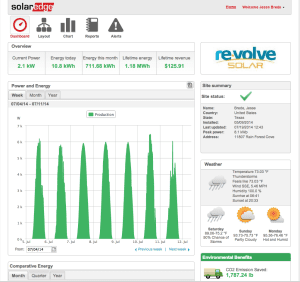 Final Thoughts
Final Thoughts
My wife and I couldn’t be happier about upgrading our home and offices to solar. We can crank up the AC a bit more and know that we aren’t taxing the grid and destroying the earth just for a little extra comfort. I’m really excited to see where the future of green energy goes in the coming years. Companies like Re:volve Solar, Solar City, and Tesla are leading the way to the future. Please leave a comment if you have any questions about taking your home or office to solar.



